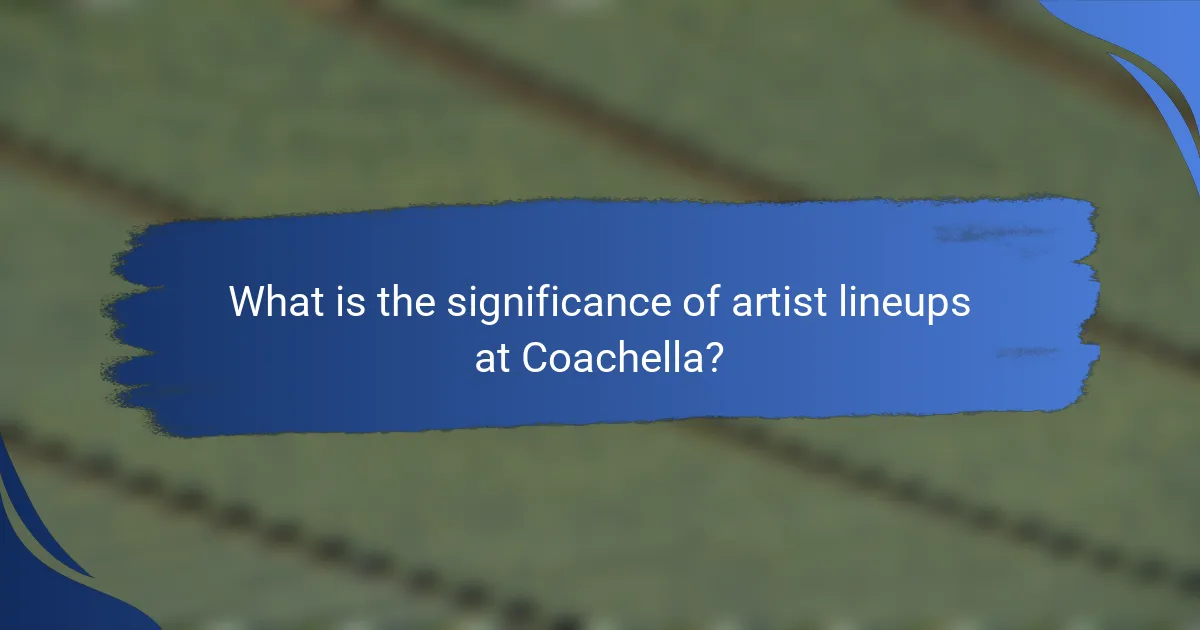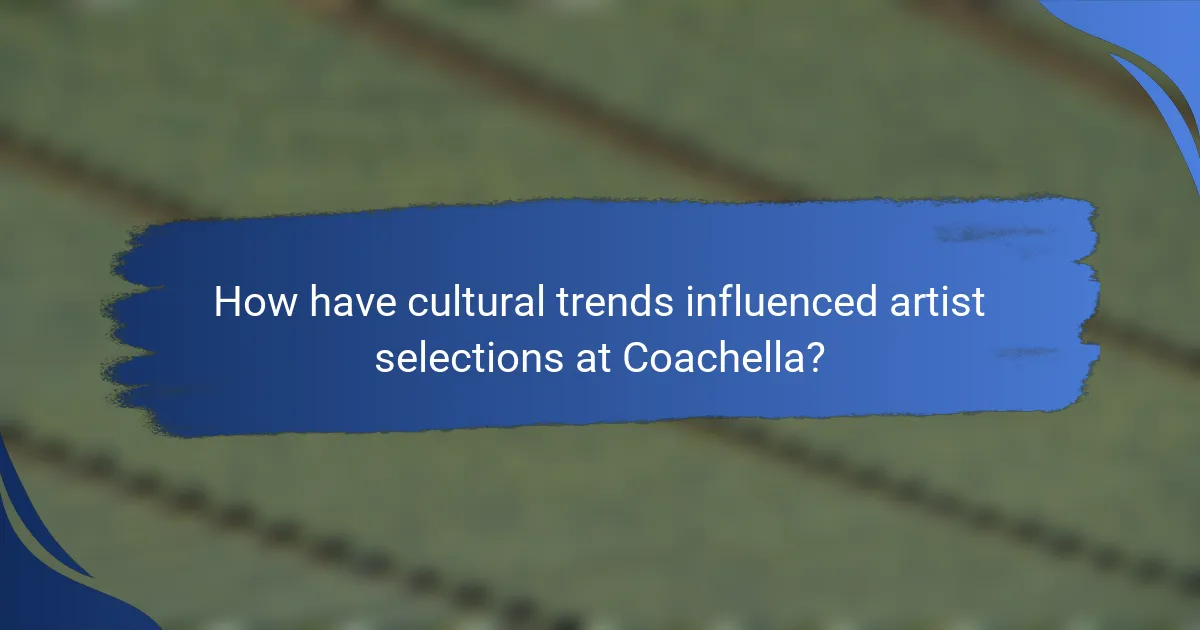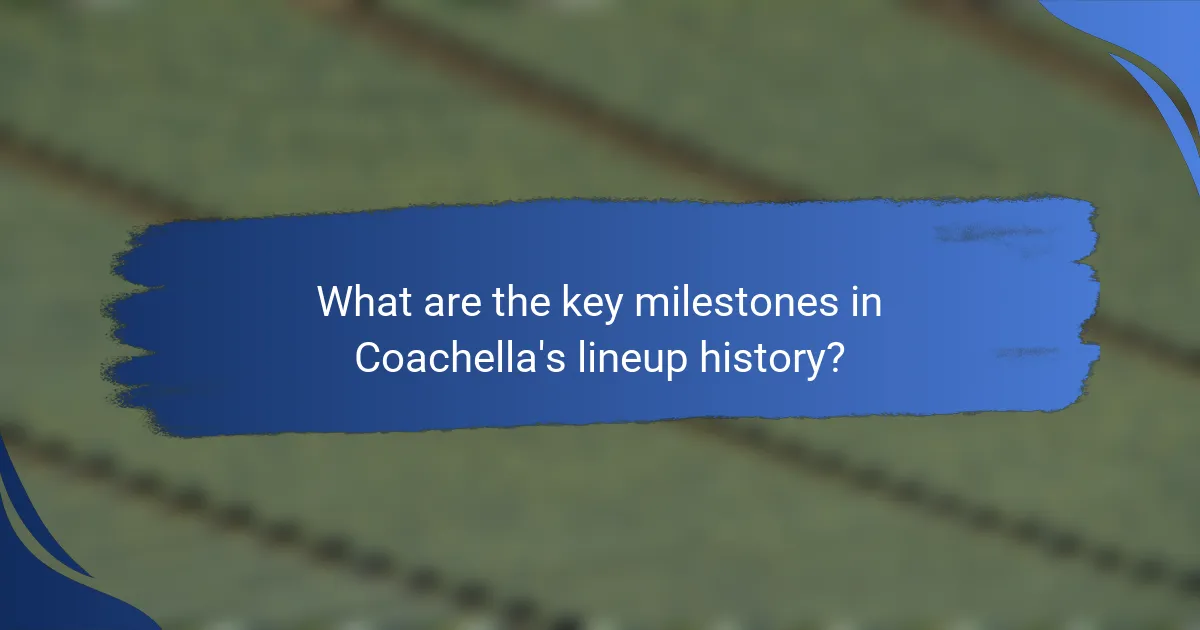The article examines the evolution of artist lineups at Coachella, a prominent music festival known for shaping the music industry’s trends and cultural identity. It highlights how the selection of artists reflects cultural diversity, emerging genres, and societal movements, impacting both audience engagement and artists’ careers. Key milestones in Coachella’s lineup history are discussed, including iconic performances and significant shifts in genre representation. The analysis emphasizes the festival’s adaptability and responsiveness to contemporary musical styles and cultural conversations, illustrating its ongoing influence in the music landscape.

What is the significance of artist lineups at Coachella?
Artist lineups at Coachella are significant because they shape the festival’s identity and influence music trends. The selection of artists reflects cultural diversity and emerging genres. Coachella has a history of featuring both mainstream and indie acts, showcasing a wide range of talent. This diversity attracts a broad audience, enhancing the festival’s reputation. Additionally, iconic performances can launch artists into stardom, impacting their careers. For example, Beyoncé’s 2018 performance solidified her status as a cultural icon. Overall, artist lineups play a crucial role in defining the festival’s legacy and its impact on the music industry.
How have artist lineups evolved since Coachella’s inception?
Artist lineups at Coachella have evolved significantly since the festival’s inception in 1999. Initially, the festival featured a mix of alternative rock and indie bands. Over the years, the lineup has diversified to include a wide range of genres, including hip-hop, electronic, and pop. In its early years, headliners were primarily rock-oriented, such as Beck and Radiohead. By the 2010s, major pop artists like Beyoncé and Lady Gaga began to headline. The inclusion of diverse acts reflects broader cultural trends and audience preferences. Additionally, the festival has increasingly showcased international artists, highlighting global music trends. This evolution mirrors the changing landscape of the music industry and festival culture.
What were the initial criteria for selecting artists in the early years?
The initial criteria for selecting artists in the early years of Coachella focused on diversity and genre representation. Organizers aimed to create a lineup that included a mix of rock, electronic, and alternative music. They sought both established acts and emerging talent to appeal to a broad audience. The festival prioritized artists with a strong live performance reputation. Additionally, regional acts were included to promote local talent. This approach helped establish Coachella as a unique festival experience. The commitment to varied genres attracted a diverse crowd, enhancing the festival’s popularity.
How did the diversity of genres in lineups change over time?
The diversity of genres in lineups at Coachella has significantly increased over time. Initially, the festival primarily featured rock and alternative music. As years progressed, electronic, hip-hop, and pop genres gained prominence. By 2010, the lineup included a mix of indie, electronic, and hip-hop artists. In recent years, there has been a notable inclusion of diverse cultural representations. This shift reflects broader music industry trends and audience preferences. For example, in 2022, artists from various global backgrounds were prominently featured. The festival now showcases a wider array of genres, appealing to a more diverse audience.
What impact do artist lineups have on festival attendance?
Artist lineups significantly impact festival attendance. A strong lineup attracts larger crowds. For instance, Coachella’s attendance often spikes with high-profile headliners. In 2017, the festival reached 250,000 attendees, largely due to artists like Beyoncé and Radiohead. Additionally, diverse lineups appeal to various demographics. This broadens the audience and increases ticket sales. Research shows that festivals with popular artists see a 20-30% increase in attendance compared to those with less known acts. Thus, artist lineups play a crucial role in determining festival success and attendance rates.
How do headliners influence ticket sales and audience demographics?
Headliners significantly influence ticket sales and audience demographics. Popular headliners attract larger crowds, driving higher ticket sales. For example, Coachella’s top acts like Beyoncé and Radiohead have historically sold out within hours. This demand reflects their broad appeal across various demographics. Headliners often draw fans from different age groups, increasing diversity in the audience. Additionally, the presence of well-known acts can enhance the festival’s overall reputation. Festivals with big-name headliners generally see a spike in attendance and media coverage. This visibility can lead to a more varied audience, as fans of different genres converge. Thus, headliners play a crucial role in shaping both ticket sales and the demographic makeup of festival attendees.
What role do emerging artists play in shaping the festival experience?
Emerging artists significantly enhance the festival experience by introducing fresh sounds and innovative performances. They often attract diverse audiences seeking new music. Festivals like Coachella have increasingly featured emerging talent, reflecting a shift towards inclusivity. This approach fosters a sense of discovery among attendees. Emerging artists also contribute to the festival’s cultural relevance. Their unique perspectives often resonate with younger audiences. This dynamic creates memorable moments that define the festival atmosphere. Overall, emerging artists play a crucial role in shaping the festival landscape and its evolving identity.

How have cultural trends influenced artist selections at Coachella?
Cultural trends have significantly influenced artist selections at Coachella. The festival adapts to current musical styles and societal movements. For instance, the rise of hip-hop in mainstream music led to increased representation of hip-hop artists in lineups. Notable examples include Kendrick Lamar and Cardi B, who reflect this genre’s popularity. Additionally, social movements like Black Lives Matter have prompted the inclusion of diverse artists. This shift highlights the festival’s responsiveness to cultural conversations. Coachella’s commitment to showcasing varied genres is evident in its evolving lineups. The festival aims to resonate with contemporary audiences by reflecting their musical preferences and values.
What social movements have impacted the choice of artists?
Social movements such as feminism, civil rights, and [censured] rights have significantly impacted artist choices. The feminist movement has led to an increased representation of female artists in music festivals. This shift is evident as Coachella has featured more female headliners over the years, reflecting societal changes. The civil rights movement has influenced artists to address social justice themes in their work. Many musicians now incorporate activism into their performances. The [censured] rights movement has also shaped the lineup, promoting inclusivity and diversity. Coachella has increasingly showcased [censured] artists, aligning with broader societal acceptance. These movements collectively drive the evolution of artist lineups at festivals like Coachella.
How has the representation of women and minorities changed in lineups?
The representation of women and minorities in lineups has significantly improved over the years. In the early years of Coachella, female artists and artists from minority backgrounds were underrepresented. For example, in 2001, only 14% of performers were women. By 2020, this number rose to approximately 36%. Similarly, artists of color made up a small fraction of the lineup in the festival’s early years. Recent statistics indicate that 50% of the performers in 2022 identified as people of color. This shift reflects a growing awareness and commitment to diversity in music festivals. The increase in representation aligns with broader societal movements advocating for equality and inclusion.
What are some notable collaborations that emerged from Coachella lineups?
Notable collaborations that emerged from Coachella lineups include the 2012 reunion of Dr. Dre and Snoop Dogg. This performance featured guest appearances by 50 Cent and Eminem. Another significant collaboration occurred in 2016 when Beyoncé joined Coldplay on stage. This performance highlighted her song “Hymn for the Weekend.” In 2018, the surprise appearance of Eminem alongside 50 Cent and Dr. Dre marked another memorable collaboration. Additionally, in 2019, Ariana Grande brought out Nicki Minaj during her set. These collaborations showcase the festival’s ability to create unique musical moments.
How do changes in music consumption shape festival lineups?
Changes in music consumption significantly influence festival lineups. The rise of streaming services has altered how audiences discover and engage with music. Artists who gain popularity on platforms like Spotify often dominate festival bookings. Data from Billboard shows that artists with high streaming numbers attract larger crowds. Additionally, social media trends can elevate lesser-known acts, leading to diverse lineups. Festivals now prioritize genre-blending to cater to varied listener preferences. The demand for experiential engagement also shapes lineup decisions, focusing on interactive performances. Overall, evolving consumption patterns drive festivals to adapt their artist selections to meet audience expectations.
What effects have streaming services had on artist visibility at Coachella?
Streaming services have significantly increased artist visibility at Coachella. These platforms allow performances to reach a global audience in real-time. Artists who may not have a large following gain exposure through live streams. This exposure can lead to increased fan engagement and ticket sales for future events. In 2022, Coachella’s live stream attracted millions of viewers worldwide. This broad reach enhances the festival’s reputation as a launching pad for emerging talent. Additionally, streaming services provide artists with on-demand access to their performances post-festival. This access allows for continued visibility long after the event concludes.
How do social media trends influence lineup announcements?
Social media trends significantly influence lineup announcements by shaping audience expectations and artist visibility. Platforms like Twitter and Instagram allow fans to express their preferences and excitement. This real-time feedback can pressure organizers to consider popular or trending artists. Additionally, viral challenges or hashtags can elevate certain acts, making them more appealing for inclusion. Data shows that festivals responding to social media buzz often see increased ticket sales. For example, Coachella has adapted its lineup based on trending artists identified through social media analytics. This responsiveness to trends enhances engagement and aligns with audience interests.

What are the key milestones in Coachella’s lineup history?
Coachella’s lineup history features several key milestones. In 1999, the inaugural festival included acts like Beck and Rage Against the Machine. The festival gained prominence in 2001 with the first major reunion of the Pixies. In 2004, the lineup showcased a diverse range of genres, including hip-hop and electronic music. The 2012 festival marked the first time a headliner, Dr. Dre, incorporated hologram technology during a performance. In 2016, Beyoncé’s historic performance became a cultural milestone, drawing significant media attention. The 2020 festival was canceled due to the COVID-19 pandemic, impacting the lineup for that year. In 2022, the festival returned with a lineup that included Harry Styles, Billie Eilish, and Swedish House Mafia. These milestones reflect Coachella’s evolution and influence in the music festival landscape.
Which performances are considered pivotal in Coachella’s evolution?
Beyoncé’s 2018 performance is considered pivotal in Coachella’s evolution. She became the first Black woman to headline the festival. Her show celebrated Black culture and featured a full marching band. This performance set a new standard for production and artistry at the festival. Additionally, it highlighted the importance of representation in music festivals. Another significant performance was Radiohead’s in 2017. Their set showcased a shift towards more diverse genres and experimental sounds. This performance influenced future lineups to include a wider range of musical styles. These performances have shaped the festival’s identity and artist selections over the years.
What were the standout performances that defined specific years?
The standout performances that defined specific years at Coachella include notable acts that left a lasting impact. In 2004, Radiohead’s set was praised for its atmospheric sound and emotional depth. In 2012, Dr. Dre and Snoop Dogg’s performance featured a hologram of Tupac, creating a historic moment in live music. In 2016, Beyoncé’s surprise performance drew massive attention and acclaim for its cultural significance. In 2017, Kendrick Lamar’s politically charged set resonated with the audience and showcased his lyrical prowess. These performances exemplify how specific artists shaped the festival’s identity each year.
How did unexpected artist appearances alter the festival landscape?
Unexpected artist appearances significantly transformed the festival landscape by enhancing audience engagement and generating buzz. These surprise performances create memorable experiences that attract more attendees. Festivals like Coachella have seen increased ticket sales due to the excitement surrounding unannounced acts. For instance, Beyoncé’s surprise performance in 2018 drew massive attention, boosting social media engagement. This phenomenon encourages other festivals to adopt similar strategies, leading to a trend of surprise appearances. As a result, the festival environment has become more dynamic and unpredictable. This shift has also influenced artist booking strategies, prioritizing flexibility and spontaneity. Overall, unexpected appearances have redefined audience expectations and festival marketing.
How do festival organizers curate the lineup each year?
Festival organizers curate the lineup each year by analyzing audience preferences and current music trends. They evaluate past performances to identify popular artists and genres. Organizers also consider the festival’s theme and brand identity. They seek a balance between established headliners and emerging talents. Collaborations with booking agents and record labels influence artist selection. Additionally, data from ticket sales and social media engagement inform their choices. This strategic approach ensures a diverse and appealing lineup for attendees.
What criteria do organizers use to balance established and emerging artists?
Organizers use several criteria to balance established and emerging artists. They assess the popularity and ticket sales potential of established artists. Established artists typically have a proven track record of drawing large crowds. Organizers also consider the genre diversity to appeal to a wider audience. Emerging artists are selected based on their innovative sound and potential to attract attention.
Additionally, organizers look at the festival’s brand image, ensuring a mix that aligns with its identity. They often evaluate social media presence and engagement of emerging artists. This helps gauge their influence and fanbase growth. The goal is to create a lineup that offers both nostalgia and fresh experiences for attendees.
How does audience feedback shape future lineups?
Audience feedback significantly influences future lineups. Organizers analyze audience preferences through surveys and social media engagement. This data reveals popular genres, artists, and trends. Historical examples show that requests for specific artists often lead to their inclusion in upcoming events. For instance, if a particular artist receives high engagement, they are more likely to be booked. Additionally, audience feedback can highlight gaps in diversity or genre representation. This prompts organizers to diversify future lineups to meet audience expectations. Ultimately, audience feedback helps create lineups that resonate with attendees, enhancing overall satisfaction.
What can attendees expect from future Coachella lineups?
Attendees can expect diverse artist lineups at future Coachella festivals. Historically, Coachella has featured a mix of established and emerging artists across various genres. This trend is likely to continue, showcasing a blend of pop, rock, hip-hop, and electronic music. The festival aims to highlight both mainstream and indie acts, reflecting current musical trends. Additionally, Coachella has increasingly included international artists, broadening its global appeal. In recent years, the festival has also focused on inclusivity, featuring more female and non-binary performers. As a result, attendees can anticipate innovative collaborations and unique performances. Overall, future lineups will likely maintain Coachella’s reputation as a premier music event.
How might technological advancements influence artist selections?
Technological advancements can significantly influence artist selections by expanding the methods of discovery and engagement. Artists can now utilize social media platforms to showcase their work and reach broader audiences. Streaming services provide data analytics that help curators understand listener preferences and trends. Enhanced sound and lighting technology can attract artists who prioritize high-quality performances. Virtual reality and augmented reality experiences can create new opportunities for artists to connect with fans. Additionally, advancements in music production software allow for diverse sounds, enabling a wider range of artists to be considered for lineups. Historical data shows that festivals increasingly prioritize artists who leverage these technologies for promotion and audience engagement.
What trends are emerging for upcoming festivals based on past lineups?
Emerging trends for upcoming festivals indicate a growing diversity in artist lineups. Festivals are increasingly featuring a mix of genres, blending mainstream and indie acts. There is a notable rise in female artists and underrepresented groups. Data shows that festivals are incorporating more international acts to attract global audiences. Additionally, headliners are often drawn from viral sensations and social media influencers. This shift reflects changing audience preferences for fresh and unique experiences. Past lineups at Coachella have demonstrated this evolution, with significant representation from various music styles and backgrounds.
The main entity of this article is the evolution of artist lineups at Coachella, a prominent music festival. The article examines the significance of artist selections in shaping the festival’s identity, cultural diversity, and influence on music trends. It outlines how lineups have evolved since Coachella’s inception in 1999, highlighting changes in genre representation, the impact of social movements, and the role of emerging artists. Additionally, it discusses the effects of streaming services and social media on artist visibility and audience engagement, along with key milestones and pivotal performances that have defined the festival’s legacy.